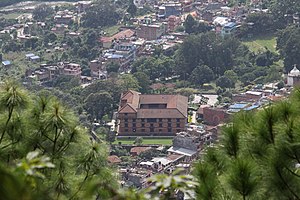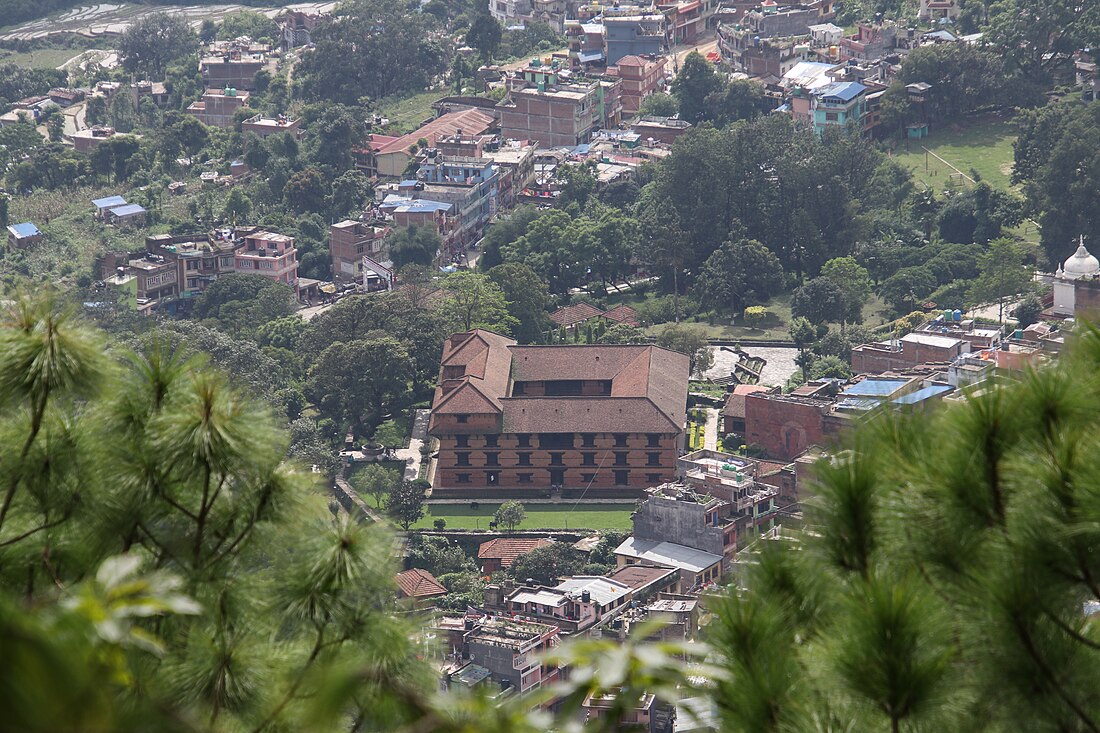Gorkha District (Nepali: गोरखा जिल्ला ), a part of Gandaki Province, is one of 77 districts of Nepal, and the fourth largest district of the country in terms of area. It is historically linked with the creation of modern Nepal and the name of the legendary Gorkha soldiers. The district, with Gorkha Municipality (previously known as Prithvi Narayan Municipality) as its district headquarters, covers an area of 3,610 km2 (1,390 sq mi) and has a population of 252,201, according to the 2021 Nepal census. Gorkha district is the site of the Manakamana Temple,[1] as well as Gorakhnath and Gorakh Kali temples. Several major rivers—including the Chepe, Daraudi, Marsyangdi, Budi Gandaki, and Trishuli—run through the district.
Gorkha District
गोरखा | |
|---|---|
 Gorkha museum in Gorkha | |
 Location of Gorkha (dark yellow) in Gandaki Province | |
| Coordinates: 28°17′N 84°41′E | |
| Country | Nepal |
| Province | Gandaki Province |
| Established | 12th century |
| Government | |
| • Type | Coordination committee |
| • Body | DCC, Gorkha |
| Area | |
| • Total | 3,610 km2 (1,390 sq mi) |
| Population (2021) | |
| • Total | 252,201 |
| • Density | 70/km2 (180/sq mi) |
| Time zone | UTC+05:45 (NPT) |
| Telephone Code | 064 |
| Main Language(s) | Nepali, Ghale, Gurung, Magar, Newari, |
Origin of the name
Myth holds that a saint named Gorakhnath appeared for the first time in Nepal in Gorkha. There remains a cave with his paduka ('footprint') and a likeness which supports the myth. As the city was established in the place where Sage Gorakhnath appeared, it was named Gorkha.[citation needed]
Geography and climate
| Climate Zone[2] | Elevation Range | % of Area |
|---|---|---|
| Lower Tropical | below 300 meters (1,000 ft) | 0.1% |
| Upper Tropical | 300 to 1,000 meters 1,000 to 3,300 ft. |
19.8% |
| Subtropical | 1,000 to 2,000 meters 3,300 to 6,600 ft. |
14.6% |
| Temperate | 2,000 to 3,000 meters 6,400 to 9,800 ft. |
13.3% |
| Subalpine | 3,000 to 4,000 meters 9,800 to 13,100 ft. |
14.9% |
| Alpine | 4,000 to 5,000 meters 13,100 to 16,400 ft. |
10.6% |
| Nival | above 5,000 meters | 11.5% |
| Trans-Himalayan[3] | 3,000 to 6,400 meters 9,800 to 21,000 ft. |
14.8% |
Mountains
- Manaslu (8,163 m)
- Himalchuli (7,895 m)
- Shringi Himal (7,177 m)
- Buddha Himal (6,674 m)
- Ganesh Himal (7,422 m)
- Ngadi Chuli (7,871 m)
- Nar Phu : Peri Range (5,748 m)
- Ganesh VI : Ganesh Himal range (6,480 m)
- Tobsar Peak : Shringi Himal range (6,100m)
Transport
Gorkha town has daily bus services to and from Kathmandu (six hours) and Pokhara (three hours).[5]
Demographics
At the time of the 2011 Nepal census, Gorkha District had a population of 271,061.
As their first language, 73.0% spoke Nepali, 13.4% Gurung, 4.7% Magar, 3.8% Tamang, 1.1% Ghale, 0.9% Urdu, 0.7% Newari, 0.6% Kumhali, 0.6% Chepang, 0.5% Bajjika, 0.2% Bhojpuri, 0.2% Yolmo and 0.2% other languages.[6]
Ethnicity/caste: 19.8% were Khas/Chhetri, 15.2% Hill Brahmin, 11.6% Magar, 11.5% Gurung, 7.8% Newar, 7.6% Sarki, 5.6% Kami, 4.8% Tamang, 3.0% Damai/Dholi, 3.0% Kumal, 2.5% Brahmu/Baramo, 1.9% Ghale, 1.3% Chepang/Praja, 1.1% Musalman, 1.0% Sanyasi/Dasnami, 0.8% Gharti/Bhujel, 0.3% Darai, 0.3% Thakuri, 0.2% Majhi, 0.1% Badi, 0.1% Gaine, 0.1% Rai, 0.1% Tharu and 0.2% others.[7]
Religion: 75.1% were Hindu, 19.1% Buddhist, 3.3% Christian, 1.1% Muslim, 0.6% Bon, 0.6% Prakriti and 0.1% others.[8]
Literacy: 66.1% could both read and write, 2.4% could read but not write and 31.4% could neither read nor write.[9]
| Census year | Pop. | ±% p.a. | ||
|---|---|---|---|---|
| 1981 | 231,294 | — | ||
| 1991 | 252,524 | +0.88% | ||
| 2001 | 288,134 | +1.33% | ||
| 2011 | 271,061 | −0.61% | ||
| 2021 | 252,201 | −0.72% | ||
| ||||
| Source: Citypopulation[10] | ||||
Health care

Following is the data obtained from the PHASE Nepal website:
- Central/regional/zonal hospitals: 0
- District hospitals: 2
- Primary healthcare centres: 3
- Health posts: 10
- Sub-health post: 55
- Number of doctors: 8
A district hospital is in Gorkha, the municipal hospital in Amppipal is supported by a German NGO.
The small health centers in many village development committees (VDCs) are without Auxiliary Health Workers (AHWs), Auxiliary Nurse Midwives (ANMs) and Community Health Workers (CHWs). So, people seeking emergency health assistance have to travel a long distance to the district headquarters or Kathmandu or end up dying because of lack of treatment. Many people still believe in Dhami and Jhakri and are against taking medicine or going to the hospital for the treatment. An NGO, PHASE Nepal provides many health care facilities and training programs to three VDCs: Sirdibas, Bihi/Prok and Chumchet. Many people residing in these VDCs have benefited from the program.[11]
Educational status

As per the National Population and Housing Census of Nepal 2011, the literacy rate of Gorkha is 66.34%. The female literacy rate is 59.44% and the male literacy rate is 75.09%.
Administration
The district consists of 11 Municipalities, out of which two are urban municipalities and nine are rural municipalities. These are as follows:[12]
- Gorkha Municipality
- Palungtar Municipality
- Barpak Sulikot Rural Municipality
- Siranchowk Rural Municipality
- Ajirkot Rural Municipality
- Tsum Nubri Rural Municipality
- Dharche Rural Municipality
- Bhimsen Thapa Rural Municipality
- Sahid Lakhan Rural Municipality
- Aarughat Rural Municipality
- Gandaki Rural Municipality
Former Village Development Committees
Prior to the restructuring of the district, Gorkha District consisted of the following municipalities and Village development committees:

- Aanppipal
- Aaru Arbang
- Aaru Chanuate
- Aarupokhari
- Asrang
- Baguwa
- Bakrang
- Bhirkot
- Bhumlichok
- Bihi
- Borlang
- Barpak
- Bunkot
- Chhaikampar
- Chhoprak
- Chumchet
- Chyangli
- Darbhung
- Deurali
- Dhawa
- Dhuwakot
- Gaikhur
- Gakhu
- Ghairung
- Ghyachok
- Ghyalchok
- Gorakhkali
- Gorkha Municipality
- Gumda
- Hansapur
- Harmi
- Jaubari
- Kashigaun
- Kerabari
- Kerauja
- Kharibot
- Khoplang
- Laprak
- Lapu
- Lho
- Makaising
- Manakamana
- Manbu
- Masel
- Mirkot
- Muchhok
- Namjung
- Nareshwar
- Palungtar Municipality
- Panchkhuwadeurali
- Pandrung
- Phinam
- Phujel
- Prok
- Ranishwara
- Samagaun
- Saurpani
- Srinathkot
- Simjung
- Sirdibas
- Swara
- Taklung
- Takukot
- Takumajhalakuribot
- Tandrang
- Tanglichok
- Taple
- Tara Nagar
- Thalajung
- Thumi
- Uiya
- Barpak
See also
References
External links
Wikiwand in your browser!
Seamless Wikipedia browsing. On steroids.
Every time you click a link to Wikipedia, Wiktionary or Wikiquote in your browser's search results, it will show the modern Wikiwand interface.
Wikiwand extension is a five stars, simple, with minimum permission required to keep your browsing private, safe and transparent.
